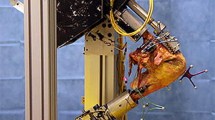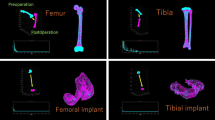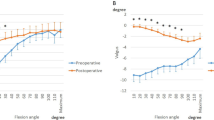Abstract
Purpose
Bicruciate-stabilised total knee arthroplasty (BCS-TKA) uses a dual-post-cam mechanism as a substitute for the anterior cruciate ligament and posterior cruciate ligament (PCL), with the surface geometry providing additional guidance for axial rotation and posterior translation. However, the effect of weight-bearing on the kinematics of BCS-TKA has not been investigated. Therefore, the aim of this study was to clarify the effect of weight-bearing on the kinematics of BCS-TKA during high-flexion activities.
Methods
The kinematics of 11 BCS-TKAs were evaluated under fluoroscopy, with two- and three-dimensional image registration, during squatting weight-bearing and active-assisted knee flexion non-weight-bearing. The following variables were measured: knee range of motion, axis of femoral rotation relative to the tibial component, anteroposterior (AP) translation of the medial contact point, kinematic path of the joint surfaces, lateral femorotibial contact point, and anterior and post-cam engagement.
Results
The weight-bearing condition did not influence the range of knee flexion, axis of femoral rotation, medial pivot pattern during early flexion, or bicondylar rollback beyond mid-flexion. With regard to AP translation, both the medial and lateral contact points had more posterior locations in weight-bearing than in non-weight-bearing at the mid-flexion angle. Anterior engagement was identified in 6/11 knees (54.5%) in weight-bearing and 4/11 knees (36.3%) in non-weight-bearing. Post-cam engagement was observed in all knees, with the angle of flexion at engagement being larger in weight-bearing than in non-weight-bearing.
Conclusion
Although weight-bearing resulted in a posterior location of the medial and lateral contact points of the BCS-TKA design compared with non-weight-bearing in the mid-range of knee flexion, the amount of anterior translation was small overall. Therefore, BCS-TKA provides good stability during high-flexion weight-bearing activities. However, BCS-TKA is associated with high rate of the anterior engagement during early flexion. Therefore, understanding a patient’s activities is an important factor when selecting the most appropriate TKA method.




Similar content being viewed by others
References
Arbuthnot JE, Brink RB (2009) Assessment of the antero-posterior and rotational stability of the anterior cruciate ligament analogue in a guided motion bi-cruciate stabilized total knee arthroplasty. J Med Eng Technol 33:610–615
Banks SA, Markovich GD, Hodge WA (1997) In vivo kinematics of cruciate-retaining and -substituting knee arthroplasties. J Arthroplasty 12:297–304
Brilhault J, Ries MD (2010) Measuring patellar height using the lateral active flexion radiograph: effect of total knee implant design. Knee 17:148–151
Catani F, Ensini A, Belvedere C, Feliciangeli A, Benedetti MG, Leardini A et al (2009) In vivo kinematics and kinetics of a bi-cruciate substituting total knee arthroplasty: a combined fluoroscopic and gait analysis study. J Orthop Res 27:1569–1575
Dennis DA, Komistek RD, Colwell CE Jr, Ranawat CS, Scott RD, Thornhill TS et al (1998) In vivo anteroposterior femorotibial translation of total knee arthroplasty: a multicenter analysis. Clin Orthop Relat Res 356:47–57
Dennis DA, Komistek RD, Mahfouz MR (2003) In vivo fluoroscopic analysis of fixed-bearing total knee replacements. Clin Orthop Relat Res 410:114–130
Dennis DA, Komistek RD, Mahfouz MR, Walker SA, Tucker A (2004) A multicenter analysis of axial femorotibial rotation after total knee arthroplasty. Clin Orthop Relat Res 428:180–189
Ewald FC (1989) The Knee Society total knee arthroplasty roentgenographic evaluation and scoring system. Clin Orthop Relat Res 248:9–12
Fujimoto E, Sasashige Y, Tomita T, Iwamoto K, Masuda Y, Hisatome T (2014) Significant effect of the posterior tibial slope on the weight-bearing, midflexion in vivo kinematics after cruciate-retaining total knee arthroplasty. J Arthroplasty 29:2324–2330
Grieco TF, Sharma A, Dessinger GM, Cates HE, Komistek RD (2018) In vivo kinematic comparison of a bicruciate stabilized total knee arthroplasty and the normal knee using fluoroscopy. J Arthroplasty 33:565–571
Grood ES, Suntay WJ (1983) A joint coordinate system for the clinical description of three-dimensional motions: application to the knee. J Biomech Eng 105:136–144
Hada M, Mizu-Uchi H, Okazaki K, Kaneko T, Murakami K, Ma Y et al (2018) Bi-cruciate stabilized total knee arthroplasty can reduce the risk of knee instability associated with posterior tibial slope. Knee Surg Sports Traumatol Arthrosc 26:1709–1716
Horiuchi H, Akizuki S, Tomita T, Sugamoto K, Yamazaki T, Shimizu N (2012) In vivo kinematic analysis of cruciate-retaining total knee arthroplasty during weight-bearing and non–weight-bearing deep knee bending. J Arthroplasty 27:1196–1202
Inui H, Taketomi S, Yamagami R, Shirakawa N, Kawaguchi K, Tanaka S (2018) The relationship between soft-tissue balance and intraoperative kinematics of guided motion total knee arthroplasty. J Knee Surg. https://doi.org/10.1055/s-0038-1636545
Kaneko T, Kono N, Mochizuki Y, Hada M, Toyoda S, Musha Y (2017) Bi-cruciate substituting total knee arthroplasty improved medio-lateral instability in mid-flexion range. J Orthop 14:201–206
Kitagawa A, Tsumura N, Chin T, Gamada K, Banks SA, Kurosaka M (2010) In vivo comparison of knee kinematics before and after high-flexion posterior cruciate-retaining total knee arthroplasty. J Arthroplasty 25:964–969
Komistek RD, Dennis DA, Mahfouz M (2003) In vivo fluoroscopic analysis of the normal human knee. Clin Orthop Relat Res 40:69–81
Kono K, Tomita T, Futai K, Yamazaki T, Tanaka S, Yoshikawa H et al (2018) In vivo three-dimensional kinematics of normal knees during different high-flexion activities. Bone Jt J 100-b:50–55
Kuroyanagi Y, Mu S, Hamai S, Robb WJ, Banks SA (2012) In vivo knee kinematics during stair and deep flexion activities in patients with bicruciate substituting total knee arthroplasty. J Arthroplasty 27:122–128
Lavallee S, Szeliski R (1995) Recovering the position and orientation of free-form objects from image contours using 3D distance maps. IEEE Trans Pattern Anal Mach Intell 17:378–390
Luyckx L, Luyckx T, Bellemans J, Victor J (2010) Iliotibial band traction syndrome in guided motion TKA. A new clinical entity after TKA. Acta Orthop Belg 76:507–512
Moro-oka TA, Hamai S, Miura H, Shimoto T, Higaki H, Fregly BJ et al (2008) Dynamic activity dependence of in vivo normal knee kinematics. J Orthop Res 26:428–434
Murakami K, Hamai S, Okazaki K, Ikebe S, Shimoto T, Hara D et al (2016) In vivo kinematics of healthy male knees during squat and golf swing using image-matching techniques. Knee 23:221–226
Nakamura S, Ito H, Yoshitomi H, Kuriyama S, Komistek RD, Matsuda S (2015) Analysis of the flexion gap on in vivo knee kinematics using fluoroscopy. J Arthroplasty 30:1237–1242
Scarvell JM, Perriman DM, Smith PN, Campbell DG, Bruce WJM, Nivbrant B (2017) Total knee arthroplasty using bicruciate-stabilized or posterior-stabilized knee implants provided comparable outcomes at 2 years: a prospective, multicenter, randomized, controlled, clinical trial of patient outcomes. J Arthroplasty 32:3356–3363
Shelburne KB, Pandy MG (1998) Determinants of cruciate-ligament loading during rehabilitation exercise. Clin Biomech 13:403–413
Shimizu N, Tomita T, Yamazaki T, Yoshikawa H, Sugamoto K (2011) The effect of weight-bearing condition on kinematics of a high-flexion, posterior-stabilized knee prosthesis. J Arthroplasty 26:1031–1037
Stiehl JB, Komistek RD, Dennis DA (1999) Detrimental kinematics of a flat on flat total condylar knee arthroplasty. Clin Orthop Relat Res 365:139–148
Stiehl JB, Komistek RD, Dennis DA, Paxson RD, Hoff WA (1995) Fluoroscopic analysis of kinematics after posterior-cruciate-retaining knee arthroplasty. J Bone Jt Surg Br 77:884–889
Tsukiyama H, Kuriyama S, Kobayashi M, Nakamura S, Furu M, Ito H et al (2017) Medial rather than lateral knee instability correlates with inferior patient satisfaction and knee function after total knee arthroplasty. Knee 24:1478–1484
Victor J, Bellemans J (2006) Physiologic kinematics as a concept for better flexion in TKA. Clin Orthop Relat Res 452:53–58
Victor J, Mueller JK, Komistek RD, Sharma A, Nadaud MC, Bellemans J (2010) In vivo kinematics after a cruciate-substituting TKA. Clin Orthop Relat Res 468:807–814
Yamazaki T, Watanabe T, Nakajima Y, Sugamoto K, Tomita T, Maeda D et al (2005) Visualization of femorotibial contact in total knee arthroplasty using X-ray fluoroscopy. Eur J Radiol 53:84–89
Yamazaki T, Watanabe T, Nakajima Y, Sugamoto K, Tomita T, Yoshikawa H et al (2004) Improvement of depth position in 2-D/3-D registration of knee implants using single-plane fluoroscopy. IEEE Trans Med Imaging 23:602–612
Yoshiya S, Matsui N, Komistek RD, Dennis DA, Mahfouz M, Kurosaka M (2005) In vivo kinematic comparison of posterior cruciate-retaining and posterior stabilized total knee arthroplasties under passive and weight-bearing conditions. J Arthroplasty 20:777–783
Yue B, Varadarajan KM, Moynihan AL, Liu F, Rubash HE, Li G (2011) Kinematics of medial osteoarthritic knees before and after posterior cruciate ligament retaining total knee arthroplasty. J Orthop Res 29:40–46
Zambianchi F, Fiacchi F, Lombari V, Venturelli L, Marcovigi A, Giorgini A et al (2018) Changes in total knee arthroplasty design affect in-vivo kinematics in a redesigned total knee system: a fluoroscopy study. Clin Biomech 54:92–102
Zuffi S, Leardini A, Catani F, Fantozzi S, Cappello A (1999) A model-based method for the reconstruction of total knee replacement kinematics. IEEE Trans Med Imaging 18:981–991
Funding
There is no funding source.
Author information
Authors and Affiliations
Corresponding author
Ethics declarations
Conflict of interest
The authors declare that they have no conflict of interest.
Ethical approval
Institutional review board approval was received for this study.
Informed consent
All patients provided written informed consent.
Additional information
Publisher’s Note
Springer Nature remains neutral with regard to jurisdictional claims in published maps and institutional affiliations.
Electronic supplementary material
Below is the link to the electronic supplementary material.
Supplementary material 1 (MP4 4979 KB)
Rights and permissions
About this article
Cite this article
Kono, K., Inui, H., Tomita, T. et al. Bicruciate-stabilised total knee arthroplasty provides good functional stability during high-flexion weight-bearing activities. Knee Surg Sports Traumatol Arthrosc 27, 2096–2103 (2019). https://doi.org/10.1007/s00167-019-05375-9
Received:
Accepted:
Published:
Issue Date:
DOI: https://doi.org/10.1007/s00167-019-05375-9




